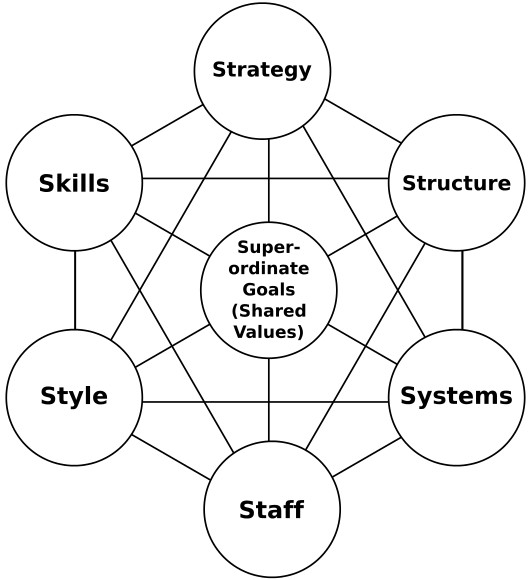The McKinsey 7S Framework is a management model developed by well-known business consultants Robert H. Waterman, Jr. and Tom Peters (who also developed the MBWA– “Management By Walking Around” motif, and authored In Search of Excellence) in the 1980s. This was a strategic vision for groups, to include businesses, business units, and teams. The 7S are structure, strategy, systems, skills, style, staff and shared values.
The model is most often used as an organizational analysis tool to assess and monitor changes in the internal situation of an organization.
The model is based on the theory that, for an organization to perform well, these seven elements need to be aligned and mutually reinforcing. So, the model can be used to help identify what needs to be realigned to improve performance, or to maintain alignment (and performance) during other types of change.
Whatever the type of change – restructuring, new processes, organizational merger, new systems, change of leadership, and so on – the model can be used to understand how the organizational elements are interrelated, and so ensure that the wider impact of changes made in one area is taken into consideration.
The 7 Elements
The McKinsey 7-S model involves seven interdependent factors which are categorized as either “hard” or “soft” elements:
“Hard” elements are easier to define or identify and management can directly influence them.
These are strategy, Structure and systems.
“Soft” elements, on the other hand, can be more difficult to describe, and are less tangible and more influenced by culture. However, these soft elements are as important as the hard elements if the organization is going to be successful. These are Shared Values, Style, Staff, Skills.
Let’s look at each of the elements specifically:
Strategy: the plan devised to maintain and build competitive advantage over the competition.
Structure: the way the organization is structured and who reports to whom.
Systems: the daily activities and procedures that staff members engage in to get the job done.
Shared Values: called “superordinate goals” when the model was first developed, these are the core values of the company that are evidenced in the corporate culture and the general work ethic.
Style: the style of leadership adopted.
Staff: the employees and their general capabilities.
Skills: the actual skills and competencies of the employees working for the company.
The McKinsey 7-S model

Placing Shared Values in the middle of the model emphasizes that these values are central to the development of all the other critical elements. The company’s structure, strategy, systems, style, staff and skills all stem from why the organization was originally created, and what it stands for. The original vision of the company was formed from the values of the creators. As the values change, so do all the other elements.
The model is based on the theory that, for an organization to perform well, these seven elements need to be aligned and mutually reinforcing. So, the model can be used to help identify what needs to be realigned to improve performance, or to maintain alignment (and performance) during other types of change.
Whatever the type of change restructuring, new processes, organizational merger, new systems, change of leadership, and so on the model can be used to understand how the organizational elements are interrelated, and so ensure that the wider impact of changes made in one area is taken into consideration.
The 7-S model can be used to help analyze the current situation (Point A), a proposed future situation (Point B) and to identify gaps and inconsistencies between them. It’s then a question of adjusting and tuning the elements of the 7-S model to ensure that an organization works effectively and well once you reach the desired endpoint.

